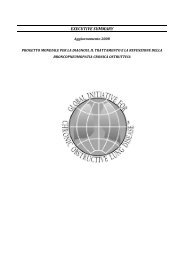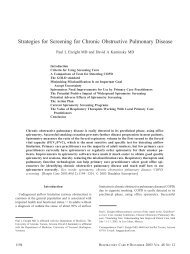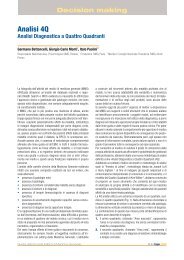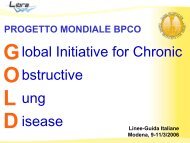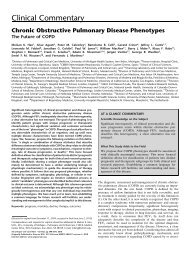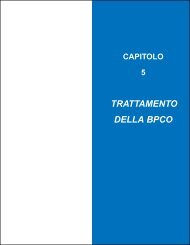Global Initiative for Chronic Obstructive Lung Disease - GOLD
Global Initiative for Chronic Obstructive Lung Disease - GOLD
Global Initiative for Chronic Obstructive Lung Disease - GOLD
You also want an ePaper? Increase the reach of your titles
YUMPU automatically turns print PDFs into web optimized ePapers that Google loves.
<strong>GOLD</strong>_WR_05 8/18/05 12:56 PM Page 15<br />
additional in<strong>for</strong>mation is available from the WHO<br />
Evidence <strong>for</strong> Health Policy Department 27 .) However,<br />
inconsistent use of terminology <strong>for</strong> COPD causes<br />
problems that do not arise <strong>for</strong> many other diseases.<br />
For example, prior to about 1968 and the Eighth<br />
Revision of the ICD, the terms "chronic bronchitis" and<br />
"emphysema" were used extensively. During the<br />
1970s, the term "COPD" increasingly replaced those<br />
terms in the US and some but not all other countries,<br />
making comparisons of COPD mortality in different<br />
countries very difficult. However, the situation has<br />
improved with the Ninth and Tenth Revisions of the<br />
ICD, in which deaths from COPD or chronic airways<br />
obstruction are included in the broad category of<br />
"COPD and allied conditions" (ICD-9 codes 490-496<br />
and ICD-10 codes J42-46).<br />
The age-adjusted death rates <strong>for</strong> COPD by race and<br />
sex in the US from 1960 to 1996 by ICD code are<br />
shown in Figure 2-3 17 . COPD death rates are very<br />
low among people under age 45 in the US, but then<br />
increase with age, and COPD becomes the fourth or<br />
fifth leading cause of death among those over 45 17 , a<br />
pattern that reflects the cumulative effect of cigarette<br />
smoking 28 . Although appreciable variations in mortality<br />
across developed countries <strong>for</strong> both genders have been<br />
reported 29 , these differences should be interpreted<br />
cautiously. Differences between countries in death<br />
certification, diagnostic practices, the structure of<br />
health care systems, and life expectancy have an<br />
appreciable impact on reported mortality rates.<br />
Figure 2-3. Age-Adjusted* Death Rates <strong>for</strong><br />
<strong>Chronic</strong> <strong>Obstructive</strong> Pulmonary <strong>Disease</strong> by<br />
Race and Sex, US 1960-1996 17<br />
ECONOMIC AND SOCIAL<br />
BURDEN OF COPD<br />
Because COPD is highly prevalent and can be severely<br />
disabling, direct medical expenditures and the indirect<br />
costs of morbidity and premature mortality from COPD<br />
can represent a substantial economic and social burden<br />
<strong>for</strong> societies and public and private insurance payers<br />
worldwide. Nevertheless, very little quantitative in<strong>for</strong>mation<br />
concerning the economic and social burden of COPD<br />
is available in the literature today.<br />
Economic Burden<br />
Cost of illness studies provide insight into the economic<br />
impact of a disease. Some countries attempt to separate<br />
economic burden into disease-attributable direct and indirect<br />
costs. The direct cost is the value of health care<br />
resources devoted to diagnosis and medical management<br />
of the disease. Indirect costs reflect the monetary<br />
consequences of disability, missed work and school,<br />
premature mortality, and caregiver or family costs resulting<br />
from the illness. Data on these topics from developing<br />
countries are not available, but data from the US and<br />
some European countries provide an understanding of<br />
the economic burden of COPD in developed countries.<br />
United States. Figure 2-4 compares the estimated costs<br />
of various lung disorders in the US in 1993. In 1993, the<br />
annual economic burden of COPD in the US was estimated<br />
at $23.9 billion 17 , including $14.7 billion in direct expenditures<br />
<strong>for</strong> medical care services, $4.7 billion in indirect morbidity<br />
costs, and $4.5 billion in indirect costs related to premature<br />
mortality. With an estimated 15.7 million cases of COPD<br />
in the US 30 , the estimated direct cost of COPD is $1,522<br />
per COPD patient per year.<br />
Rate/100,000 Population<br />
ICD/7<br />
ICD/8<br />
ICD/9<br />
Figure 2-4. Direct and Indirect Costs of<br />
<strong>Lung</strong> <strong>Disease</strong>s, 1993 (US $ Billions) 17<br />
White Male<br />
Black Male**<br />
Condition<br />
Total<br />
Cost<br />
Direct<br />
Medical<br />
Cost<br />
Mortality-<br />
Related<br />
Indirect<br />
Cost<br />
Morbidity-<br />
Related<br />
Indirect<br />
Cost<br />
Total<br />
Indirect<br />
Cost<br />
White Female<br />
Black Female**<br />
1960 62 64 66 68 70 72 74 76 78 80 82 84 86 88 90 92 94 1996<br />
*Age-adjusted to the 2000 standard **Nonwhite from 1960 to 1967.<br />
COPD 23.9 14.7 4.5 4.7 9.2<br />
Asthma 12.6 9.8 0.9 0.9 2.8<br />
Influenza 14.6 1.4 0.1 13.1 13.2<br />
Pneumonia 7.8 1.7 4.6 1.5 6.1<br />
Tuberculosis 1.1 0.7 - - 0.4<br />
<strong>Lung</strong> Cancer 25.1 5.1 17.1 2.9 20.0<br />
BURDEN OF COPD 15


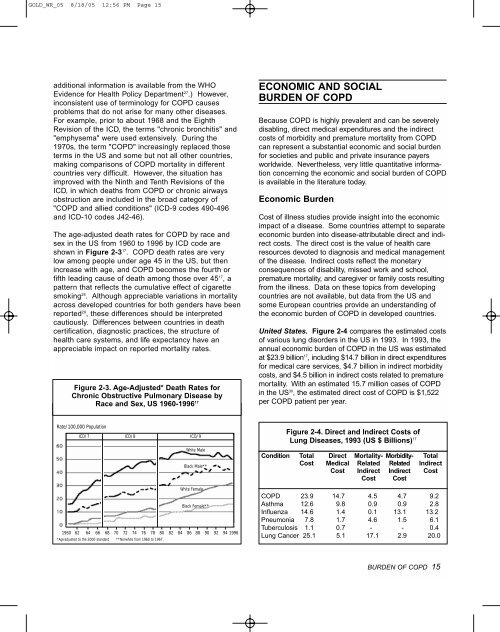
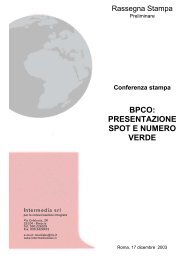
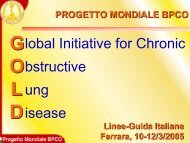
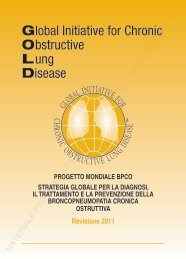
![Di Bari [NO].pdf - GOLD](https://img.yumpu.com/21544924/1/190x143/di-bari-nopdf-gold.jpg?quality=85)

